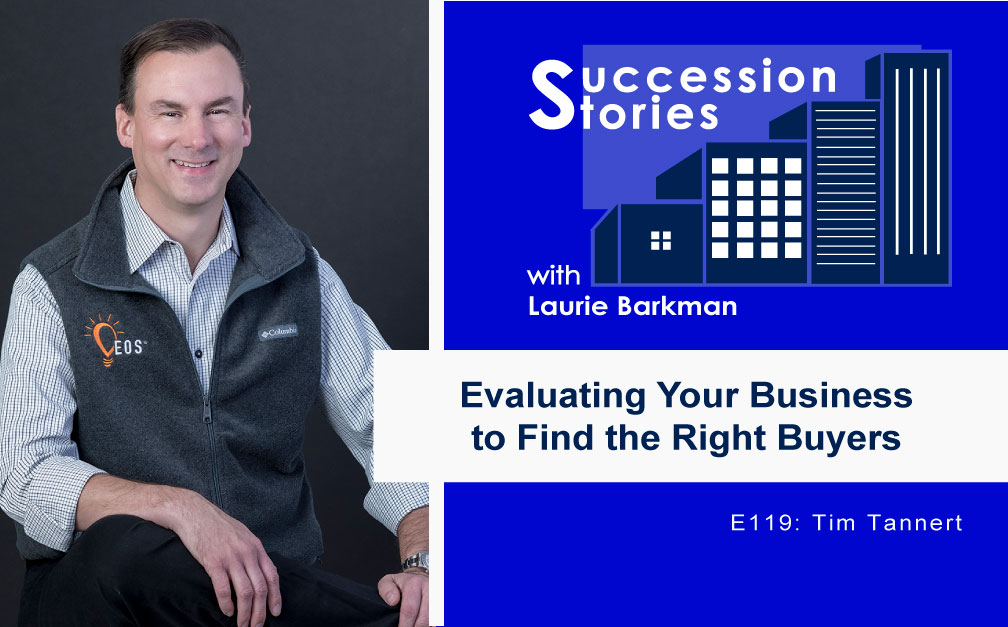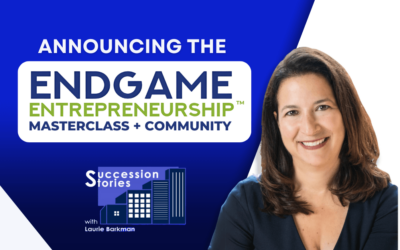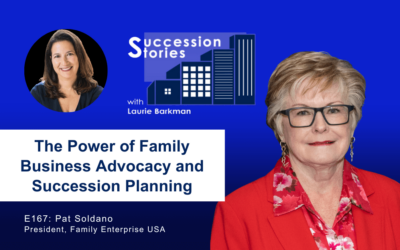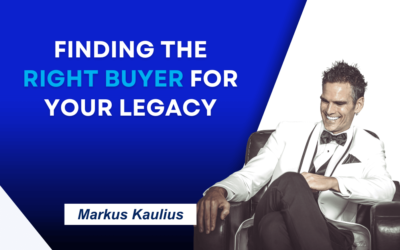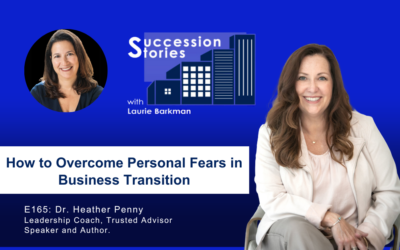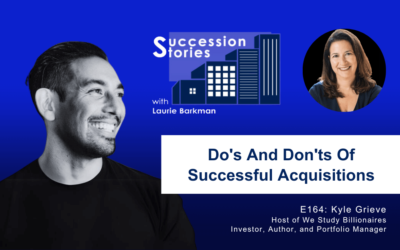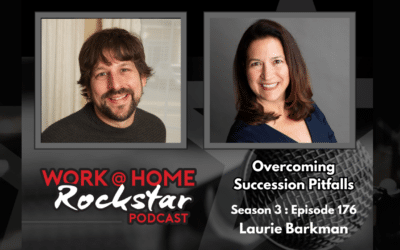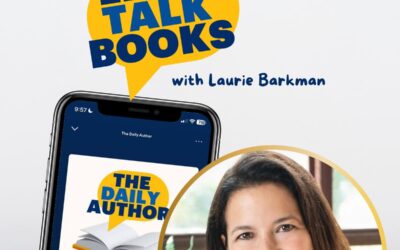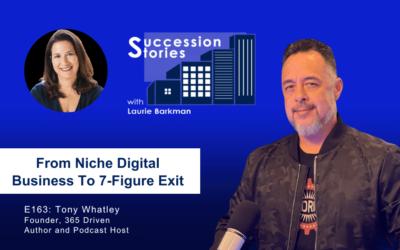What is it like to sell your same business twice? As CEO of a pharmacy software company, Tim Tannert led the business through two successful transactions. Key to their success was having a differentiated niche and strong market position. This enabled them to construct a sale process where they could select a partner that was the best fit. Tim talks about being open and honest with yourself. Evaluate your team and business to find the resources you need to take the company to the next level. Ultimately, Tim’s company selected a partner that had the size, scale, and infrastructure to achieve their goals.
Today Tim works with companies to develop success strategies as an EOS Implementer. This episode focuses on a key decision step for owners: determining who should own your business after you. Enjoy this Succession Stories episode about evaluating your business to find the right buyers with Tim Tannert.
Listen in to learn more about:
- Getting a second bite at the apple through follow-on exit to strategic buyer
- Developing market niche and recurring revenue
- Creating a bid process for an exit
- Finding right fit for potential buyers
- Lessons learned from the diligence process
- For more info on this topic, pick up a copy of Laurie Barkman’s new book, “The Business Transition Handbook”
If you enjoy Succession Stories, please leave a 5-star rating and review on Apple Podcasts!
Show links:
- https://www.eosworldwide.com/tim-tannert
- Complete a Value Builder Business Assessment at MyTransitionScore.com
- Order your copy of “The Business Transition Handbook,” an Amazon best-seller https://amzn.to/3Hqj2eo
- Decide When to Sell eBook: https://bit.ly/endgame-ebook
- Follow the Succession Stories YouTube Channel
- Connect with Laurie Barkman on LinkedIn: https://www.linkedin.com/in/lauriebarkman/
- Subscribe to The Business Transition Newsletter. Text Transition to +1-646-495-9867
About Succession Stories Podcast
Succession Stories is an award-winning podcast guiding entrepreneurs from transition to transaction. Hosted by Laurie Barkman, author of “The Business Transition Handbook: How to Avoid Transition Pitfalls and Create Valuable Exit Options.”
Get your copy at: www.theBusinessTransitionHandbook.com
Start your business transition plan by visiting: https://thebusinesstransitionsherpa.com
______________________________
SHOW SPONSOR: STONY HILL ADVISORS
Stony Hill Advisors works with owners like you to get ready and maximize value when you’re ready to sell.
Visit www.stonyhilladvisors.com/podcast for a complimentary business valuation.
Transcript
Laurie Barkman:
Hi, Tim, welcome to Succession Stories. I’m so glad you’re with me today. It’s been a while since we had spoken with each other I think we first met during COVID. To put it back about a couple of years with Vistage, is that right?
Tim Tannert:
That’s correct. You spoke at one of our Vistage meetings. Kevin Trout is our chair and I thoroughly enjoyed your presentation on exit planning.
Laurie Barkman:
Thanks so much and it’s great to be with you today. I love speaking with entrepreneurs who have a inflection point in their career, where things either go well, or don’t go well with exits and your case that things went well, which is great and we’ll talk about that, and also what you’re doing today to help entre entrepreneurs be successful in their journey. Why don’t we start with you? Why don’t you tell me your story.
Tim Tannert:
I have an interesting background, I actually started my career as a pharmacist, which is a little different and I tell people that is passionate as I was about helping make patients healthy. I quickly discovered in my career that my true passion, my true calling was to try to figure out how to make teams and companies healthy because quite frankly, a lot of the companies I worked for weren’t and so that sent me on a 20-plus year career of executive leadership, COO, CEO, ultimately running some long term care pharmacies, and then about a decade ago, I had the opportunity to move to Pittsburgh to be the chief operating officer on a small 20-plus person pharmacy software company and over the next decade, we took that company from 20, to over 150 people from one of many in the space to the clear, undisputed leader and ultimately, we sold that company twice along the way.
Laurie Barkman:
You sold it twice?
Tim Tannert:
We did. I had joined right after our first round of private equity funding, and it was my job to help grow and scale the company, I joined the COO and about three or so years later, we sold it to another private equity firm and they held us for about 18 months and we sold it again to a Fortune 500 company. That company then became a standalone division within the Fortune 500 company which I led as President/CEO for about four years.
Laurie Barkman:
Wow. That’s incredible. We do talk about the second bite at the apple you have lived that so it is not a unicorn. mythical being it does happen and you went through that just to ask you a few questions so you joined the company when it was a startup, as you said it got funding. The initial funding, was it venture backed or was private equity backed?
Tim Tannert:
It was private equity backed. We had, we were a small team, but we had a solid revenue salary EBITDA and we’re growing and so it was really more about building the systems, the processes, the tools, to be able to scale the organization, to be able to support and add clients to be able to build out the sales marketing function within the organization and just kind of repeat the model that we had already proven.
Laurie Barkman:
Was this a technology that was going to scale? Or was it the service with the people that was going to scale all the above?
Tim Tannert:
We sold software that was operating software for pharmacies, that service specifically nursing homes. So everything that the pharmacy did, whether its billing, clinical distribution, connecting with electronic health records, connecting with robotics, that was all done through our software, you can think of us as kind of the central nervous system of the pharmacy operation. And so, for us, it was really this scale of a good marketing scale, the support scale of the onboarding. This was a major enterprise installation, that every person within these companies touched our software. So we had to build the right implementation consulting, to be able to help our clients be successful with the tools that we were offering.
Laurie Barkman:
One of the things you said was you went from one of many to the undisputed leader. Tell me a little bit more about that.
Tim Tannert:
Yeah, it was an interesting journey. We had some consolidation in the space but we were able to really take off from a market share perspective, ultimately, we were able to capture the majority of the long term care independ market. We did that by capturing the upper end of that market and that our clients were the ones that were the consolidators and so as they consolidated as they added additional pharmacies, it benefited us so it was a real symbiotic relationship where we were facilitating their growth, their ability to scale, and then they were going out and doing just that.
Laurie Barkman:
How did you find that niche? How did you find that market niche?
Tim Tannert:
They had found the market niche before I joined the organization and it was kind of serendipitous to be quite honest, SoftWrite in the very beginning was a software company that worked with ADP payroll solutions, and they were helping companies that had a challenging way to pay their employees, whether it was by piece or swing shifts, or those types of things that ADP can handle and they were creating tools for them to get to the gross wages and then passing it off to ADP to go from gross than that and so they had moved into a new office building and it just happened that one of their neighbors was a dying long-term care pharmacy software system, they were down to just one or two clients. They were looking for an exit and so they ended up acquiring this company completely rewriting the software entering the market and they had a hit, they were able to bring new technology, new tools, new ways of doing things to an industry that had not seen that type of innovation before.
Laurie Barkman:
This is a software platform at the time. Would you call it a SaaS? I don’t know what year–what year were we talking about here? Is this in the 90s? In the in the 2010s?
Tim Tannert:
Yeah, it was early 2000s. We were an on premise solution, we were not SaaS, but we did have some recurring revenue as part of our model and so we were able to capitalize on having that reoccurring revenue.
Laurie Barkman:
Is that one of the things that helped gain interest from the private equity community?
Tim Tannert:
Absolutely has been that way. Yeah, we had recurring revenue, we also had an unbelievably sticky client base, we almost never lost a client because as I said, we became integrated in everything that they did and we were the market leader and so based off of that, we were able just to continue to keep that snowball growing and you know, had maintain 20 plus percent year over year CAGR and revenue growth EBIT, growth, etc. As we continue to scale and as you know, just love numbers, it gets more and more difficult to do that over a decade or two but we were able to maintain that.
Laurie Barkman:
Churn was very low. I would imagine, given the go to market strategy, the cost to acquire these customers was also fairly low or reasonable, given the size of the purchase. This was a multi– was it a multi-year contract or single-year contracts?
Tim Tannert:
It was actually a single year contract and beyond that, we went month to month, but it was just one of those evergreen type contracts but it worked for us, right, because we were so sticky, because we were able to build out that client satisfaction model where we were integral in their operations and so we were able to maintain that client base.
Laurie Barkman:
You had a market niche you had a product market fit, you found a solution, given some of the dynamics as you talked about with with ADP and fixing a real problem for for the clients. And then it was a really valuable product, it was very sticky churn was low and that created a lot of value. What was the dynamic when the company was looking for its first exit? Was it the the process to go back to the original private equity funding group and they ultimately acquired or did you create a bid process?
Tim Tannert:
We created a bid process and initially we had north of 20, probably close to 30 initial companies that received the initial sim and then from there, we whittled it down, had conversations, did management presentations, it was probably a good six to nine months of my life where I was having dinner every single night at a different Steakhouse in Pittsburgh with a different private equity company, just getting to know these people trying to identify what the right partner would be for us and ultimately, we landed in a great place and so fortunate that I was able to build great relationships with both private equity firms that held our company and I’m still close to them today, all these years laters. Matter of fact, I’m on the board of directors, and one of the port coasts for one the private equity company so it’s really important to find that right fit for you and your organization from a right strategy, right business approach, right culture, there’s a lot of different things that go into making this successful beyond just the selling price, and so I encourage people to really get to know these companies, because they’re not all the same.
Laurie Barkman:
Now, they’re not all the same were of the 20 to 30, that you sent the CIM to, which is a confidential information memorandum that includes a lot of information about the company, it’s, it’s once an NDA signed, that is sent out, did that CIM go to strategics, or just financial buyers?
Tim Tannert:
We had a couple strategics in the mix. Ultimately, it was our desire not to go that direction because we knew that we could still grow and scale, we knew we had quite a bit of runway and the leadership team wanted to continue to stay involved. We had built this thing, we we loved it, it was our baby and so that’s what led us on the first time they go to another private equity. Ultimately, a strategic came to us and they offered us a deal we couldn’t refuse and so we ended up selling to a strategic the second time around and that’s when we started seeing some change in our leadership team and, and so there was definitely changes in the organization after it happened.
Laurie Barkman:
Let’s go back to your comment about fit because this has come up every now and again, whether I’m talking to clients or whether I’m talking to folks on the show. What were the criteria in the beginning, when the management team first started the process, and were you working with an investment banker or broker or managing itself?
Tim Tannert:
No, we had a broker, we hired a broker and for us, we had a strong culture within our organization, we wanted to work with a partner that was part of that culture. The other piece too, was we knew our strengths, and we knew our weaknesses and we were really looking for a partner that could help us build up our weaknesses and so I think there’s a piece of this where you have to be open and honest with yourself, and really evaluating your team, your company and to try to find what are the resources that we need to be able to take this to the next level and so that second private equity firm, had the size and scale and the infrastructure to be able to help us to just that.
Laurie Barkman:
Think back to the diligence, I know, it was probably painful at the time, it can be a lot of questions back and forth. What stands out in your memory about the diligence process that–let’s call it hot buttons for them–where they really wanted to dig in and spend a lot of time?
Tim Tannert:
A lot on the accounting side, quite honestly, right? Understanding everything from revenue recognition to just all of the basics that we had in place and so the more that you can go into this process with your i’s dotted and your t’s crossed, you have your act together because it’s really the first several weeks of the diligence process, it’s gonna set the stage and what they find right if they go in and everything that they find is buttoned up. The process goes a lot smoother if you go in and the first couple of things I look at there’s errors or numbers changing or they felt like they don’t have the entire picture that they thought they had at the time when making that initial offer. Things are gonna get difficult and intelligence per decimals?
Laurie Barkman:
Absolutely. Having the financials in really good shape is critical and oftentimes that companies can start there. Even if they have QuickBooks, I’m sure you see this with your clients just to be consistent, stay organized, and to really be able to show the story, which you did so if you look back, what do you think are some of the key lessons that you learned through that process that you might suggest to a founder or an owner who’s listening and thinking, “Oh, one day, I might want to have an exit, a successful exit, depending on who we sell it to,” and all of those factors, what do you think are the biggest lessons learned?
Tim Tannert:
For me, it’s the think well beyond the investment period, so if you’re selling, let’s say private equity, the common thought is private equity is going to hold the company for about five years. Well, if that’s the case, then you have to have a really good idea of where this company needs to be 10 years from now because you’re not selling for this exit, you’re selling for the next exit so the private equity company or whoever that acquirer is has to understand how they’re going to drive value over the next five plus years, and what their potential exits going to be. This is a way for them to be more reassured that their investment is going to pay off and they have commitments that they’ve made to their investors for the type of return that they’re going to get and so you have to be able to paint that picture very clearly and so being able to have a 10-year target to be able to understand, okay, where do we need to be in one year, three years to be able to have any shot at hitting that 10-year target? What does that look like? What are we executing on today that’s going to get us there? All of those threads have to be woven into a tapestry, that’s going to make sense and I think that a lot of founders get so embedded in their business, that it makes sense to them but when they go to tell the story, it doesn’t make sense to others and so you have to be able to simplify it, you have to be able to boil it down to what are the most important things. If everything’s important, nothing is important. What are the three things that we’re going to drive to move this organization forward?
I’m an avid reader and one of the books I love right now is The Ride of a Lifetime. The Disney story. Disney was able to build a strategic plan focused on three things and this is Disney movies, cruise ships, and theme parks. All of the things, they had three things in their strategic plan and so if Disney can do it, we sure can do it and so to be able to be able to build that story, to be able to build that plan, and then to be able to show proven execution on that plan. I’m now working in EOS and we say all the time vision without traction is hallucination. We can paint a great story but we have to show how we have the execution muscle that we are going to hit this that we’re just not lost in fantasy land and so those are the things that I think that a lot of entrepreneurs kind of get tied up in, right and kind of get off track. It’s the basics of the financials. It’s the basics of the monetization, especially software companies prove how you’re going to monetize this thing. You have the coolest software in the world if you can’t monetize it’s not investable and then from there, what’s that plan? How are you going to execute and then paint that picture?
Laurie Barkman:
I love that. I think that’s a great explanation and such an interesting example too, with with Disney Company and everything that they did to really focus. Let’s go on this path that you’ve opened the door here to EOS if listeners are wondering, what is EOS? What are we talking about here? It’s a great methodology. It’s helped a lot of companies. Were you using EOS in your prior as the COO or CEO?
Tim Tannert:
Yeah, so I brought EOS in when I became CEO, I tell people that as we were growing the company, we had tremendous growth. We were quite successful. There were times it felt like the entire organization started to shake like turbulence on an airplane and I would grab my bubble gum, duck tape, rubber bands, get my leadership team together and we tried to figure this out, we would ultimately always be able to resolve that the turbulence, we’d start growing again but the next time the turbulence hit, it would be even more violent and so in one of those cycles, so I thought to myself, there’s gotta be something I’m missing, there’s got to be something that I should be doing that I’m not and that led me to calling friends that were CEOs and just picking their brains. One of them handed me the book Traction by Gina Whitman, told me that he had started implementing EOS, the Entrepreneurial Operating System, and for me to check it out so I read the book twice, within two days, front and back, ultimately hired an EOS implementer and implemented it.
Ultimately, I tell people, I came to three major discoveries in my life. My first discovery was through EOS, I was able to make every department healthier and ultimately, I was able to build a team that could thrive without me. My second discovery was, I had gotten to the point in my career, I had had multiple successful exits I had done well, my own personal success became absolutely meaningless to me. It wasn’t what got me out of bed. It wasn’t what drove me. It wasn’t what gave me energy. I just didn’t care quite honestly, what got me energy, what made me want to get up and tackle the world every day was trying to figure out how can I make as many people around me successful as I possibly can and my third “Aha!” was the fact that I discovered I really am much more of an entrepreneur, being a publicly traded company wasn’t the right fit for me and so it was those three highs that ultimately led me to retiring from that company. In doing this, and so now I work with entrepreneurs, their leadership teams, to focus on three main things that we call vision, traction, healthy.
One vision, being able to get the entire organization aligned, where you’re going, how you’re going to get there, why it’s important, right that 10-year target building up that that execution plan is Patrick Lencioni says if you can get all the people in the same boat, pointed in the right direction, rowing together in unison, you can win in any market against any competition at any time and so that’s the vision piece, traction is then building the execution muscle across the organization. Wvery single day, 100% of people in the company are executing against that vision, turning it into a reality. You know, as I said, vision without traction is hallucination and then third, healthy; working with the leadership teams to be more open, honest, transparent, accountable, collaborative, because oftentimes, leadership teams are those things and what we see is, as the leadership team goes, so does the rest of the company and so by working on vision, traction healthy, I can help my clients be able to build organizations that can thrive without them and ultimately, that’s what drives value. In a company, your buyer needs to be able to see how this thing’s going to keep going without the founder, get the right people in the right seats, the right execution and that proven track record, all of those things drive tremendous value for exits, and sets the companies up in a position where they can sell they can attract multiple buyers and they can ultimately get to a great exit.
Laurie Barkman:
I love it. You’re singing off the same song sheet that we talk about on this show so often, which is to really not only have the people in place, but the systems the processes, but be able to execute on that growth potential, show the growth potential, share the story and create a business that can thrive without you. I love how you phrase that and it does tee up the potential relationship for folks like me. If there’s an owner who has a business that’s sell-ready when he or she is ready to sell, to quote my friend, David Weibel, who’s been on the show. That’s where someone like myself can really help take it to the next level with Exit Planning and beyond if there’s going to be an exit or transaction so thanks so much for that explanation. I’d love to have you share another quote. You shared a favorite book. You’ve shared some other resources here, but is there a favorite quote that you have that inspires you as a leader?
Tim Tannert:
Yeah, I think that so much of what is led to my success and my in life has been discipline and I think so much of what helps drive the success of EOS-run companies is we are forcing that discipline within their organization and so my favorite quote is one from Aristotle, who says, “We are what we repeatedly do. Therefore, excellence is not an act but a habit,” so you have to just be excellent every single day, you have to drive that discipline, drive that accountability, drive those practices within yourself and within your organization and if you do those things, you can’t help but achieve excellence.
Laurie Barkman:
That’s a great quote. Thanks so much, Tim, thanks so much for being on the show sharing your experience about growing a business, having a successful exit, and now how you work with companies to create amazing companies so thanks so much for joining me.
Tim Tannert:
Absolutely. Thank you so much for having me. It’s been a privilege and an honor. I loved being a part of it and thank you.
Laurie Barkman:
If people want to get in touch with you, what’s the best way to find you?
Tim Tannert:
My email is timtannert@eosworldwide.com.
Laurie Barkman:Awesome. Thank you, listeners. Listeners, thank you so much for your support. Catch Succession Stories on your favorite podcast player or YouTube, and subscribe to the show! If you want to maximize the value of your business and plan for future transition, reach out to me for a complimentary assessment at meetlauriebarkman.com. Join me next time for more insights from transition to transaction. Until then…here’s to your success.

